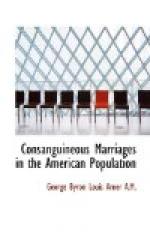[Footnote 106: Pearson and Lee, “On the Laws of Inheritance in Man,” Biometrika, vol. ii, p. 387.]
[Footnote 107: Ibid., p. 388.]
[Footnote 108: Pearson, “On the Laws of Inheritance in Man,” part 2, Biometrika, vol. iii, p. 154.]
The relative amount of degeneracy and disease among the offspring of consanguineous marriages has been enormously exaggerated, and the danger is by no means as great as is popularly supposed. Nevertheless, since it is undoubtedly true that on the average such marriages do not produce quite as healthy offspring as do non-consanguineous unions, and since public sentiment is already opposed to the marriage of cousins, it is perhaps just as well that existing laws on the subject should remain in force. From the standpoint of eugenics however, it is much more important that the marriage of persons affected with hereditary disease should be prevented. Dr. Bell has pointed out the danger of producing a deaf-mute race by the intermarriage of congenitally deaf persons,[109] and this warning should be made to apply to other congenital defects as well. Some states already prohibit the marriage of the mentally defective, and persons under the influence of intoxicants. Such provisions are wise, and are the most practical means of achieving eugenic ideals—by preventing the propagation of the unfit. The interests of society demand that the mentally and physically defective should not propagate their kind.
[Footnote 109: “Memoir upon the Formation of a Deaf Variety of the Human Race.” Memoirs of the National Academy of Sciences, vol. ii, pp. 177-262.]
From the broader viewpoint of social evolution the problems of inbreeding or crossing of stocks merge into the discussion of the endogamous and exogamous types of society. Whatever may have been the origin of exogamy, the survival of the exogamous type in progressive societies may easily be explained on the ground of superior adaptability, variability and plasticity, which enables such societies to survive a change of environment while the more rigid structure of the endogamous clan brings about its extermination.
Inbreeding leads to caste formation and a rigid and stratified social structure, which is in the end self-destructive, and cannot survive a change of environment. The governing caste may, as Reibmayr says, favor the growth of culture, but it is usually the culture of that caste, and not of the people at large. The ruling caste is usually the result of selection of the strongest and ablest, but after it becomes a caste, the individuals are selected on account of hereditary social position and not primarily on account of ability. Now biological experiments show that although artificial selection may be carried to a point where animals will breed true to a characteristic to within 90 per cent, yet if selection is stopped, and the descendants of the selected individuals are allowed to breed freely among themselves, they will in a very few generations revert to the original type. This is what happens in a social caste, unless, as in the case of the English aristocracy, it is continually renewed by selection of the ablest of the other classes.




